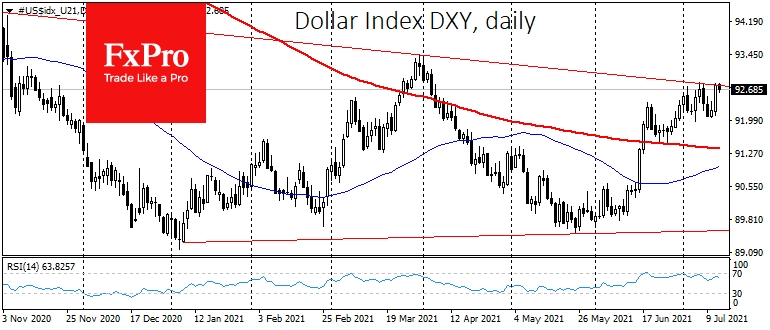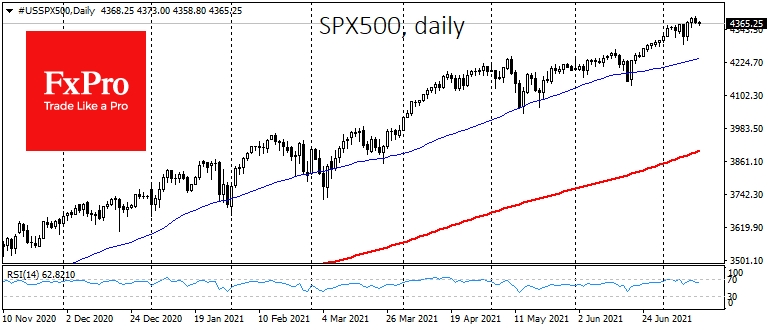Inflation in the US continues to go off the charts. Such a sharp rise reinforces the importance of action by the Fed and other policymakers, causing markets to wait tensely for their comments and hints of further moves.
The market's initial reaction to the 5.4% US inflation in June pointed to a wait-and-see attitude. The dollar index approached the resistance line of the trading range, however, it lacked the momentum to develop growth. Today the DXY is retreating from this month's highs area at 92.8, and EUR/USD is trying to get back above 1.1800.
Another indicator for market sentiment, the USD/CNH, shows a subdued momentum after the renminbi rallied slightly at the end of last week.
The same is true for the stock market. The major US indices rewrote their all-time highs and retreated slightly from their peaks late in the day, maintaining a sluggish downtrend on Wednesday morning.
The very fact of the dollar strengthening and stocks weakening at the close of the US session suggests that fund managers are banking on the Fed's increasingly hawkish rhetoric in response to an uptick in inflation.
This reaction is embedded in the reflexes of central bankers, but markets are quite sensibly pausing to clarify their position. There are reasons for this.
Since the global financial crisis, there has been chronically low inflation in the USA and several developed countries. It has become an obstacle for policy normalisation and was considered the norm even for periods of strong economic growth. This trend has recently been repeatedly referred to as the new normal, and so far, central banks are putting this scenario in their forecasts.
The second reason is the reaction of the debt markets. High inflation rates go hand in hand with falling long-term bond yields which contrast with the dynamics at the start of the year. At that time, rising inflation fears drove 10-year yields to a two year high. The debt market thus shows that long-term inflation expectations are under control as desired by the Fed.
There is still no significant pressure on the Fed to roll back stimulus despite the jump in inflation for the reasons stated above. For now, we still expect to hear official signals of an imminent QE rollback at the end of July or at the Jackson Hole symposium at the end of August.
The surprise for us will be a dramatic tightening of the tone of the US central bank or Powell at a congressional hearing today or later in the week. This would then provide the necessary impetus to break the established trend and start a dollar rally.
The FxPro Analyst Team
- English (UK)
- English (India)
- English (Canada)
- English (Australia)
- English (South Africa)
- English (Philippines)
- English (Nigeria)
- Deutsch
- Español (España)
- Español (México)
- Français
- Italiano
- Nederlands
- Português (Portugal)
- Polski
- Português (Brasil)
- Русский
- Türkçe
- العربية
- Ελληνικά
- Svenska
- Suomi
- עברית
- 日本語
- 한국어
- 简体中文
- 繁體中文
- Bahasa Indonesia
- Bahasa Melayu
- ไทย
- Tiếng Việt
- हिंदी
Dollar Doesn't Dare To Breakthrough Without A Signal From Fed
Published 07/14/2021, 05:31 AM
Updated 03/21/2024, 07:45 AM
Dollar Doesn't Dare To Breakthrough Without A Signal From Fed
Latest comments
Loading next article…
Install Our App
Risk Disclosure: Trading in financial instruments and/or cryptocurrencies involves high risks including the risk of losing some, or all, of your investment amount, and may not be suitable for all investors. Prices of cryptocurrencies are extremely volatile and may be affected by external factors such as financial, regulatory or political events. Trading on margin increases the financial risks.
Before deciding to trade in financial instrument or cryptocurrencies you should be fully informed of the risks and costs associated with trading the financial markets, carefully consider your investment objectives, level of experience, and risk appetite, and seek professional advice where needed.
Fusion Media would like to remind you that the data contained in this website is not necessarily real-time nor accurate. The data and prices on the website are not necessarily provided by any market or exchange, but may be provided by market makers, and so prices may not be accurate and may differ from the actual price at any given market, meaning prices are indicative and not appropriate for trading purposes. Fusion Media and any provider of the data contained in this website will not accept liability for any loss or damage as a result of your trading, or your reliance on the information contained within this website.
It is prohibited to use, store, reproduce, display, modify, transmit or distribute the data contained in this website without the explicit prior written permission of Fusion Media and/or the data provider. All intellectual property rights are reserved by the providers and/or the exchange providing the data contained in this website.
Fusion Media may be compensated by the advertisers that appear on the website, based on your interaction with the advertisements or advertisers.
Before deciding to trade in financial instrument or cryptocurrencies you should be fully informed of the risks and costs associated with trading the financial markets, carefully consider your investment objectives, level of experience, and risk appetite, and seek professional advice where needed.
Fusion Media would like to remind you that the data contained in this website is not necessarily real-time nor accurate. The data and prices on the website are not necessarily provided by any market or exchange, but may be provided by market makers, and so prices may not be accurate and may differ from the actual price at any given market, meaning prices are indicative and not appropriate for trading purposes. Fusion Media and any provider of the data contained in this website will not accept liability for any loss or damage as a result of your trading, or your reliance on the information contained within this website.
It is prohibited to use, store, reproduce, display, modify, transmit or distribute the data contained in this website without the explicit prior written permission of Fusion Media and/or the data provider. All intellectual property rights are reserved by the providers and/or the exchange providing the data contained in this website.
Fusion Media may be compensated by the advertisers that appear on the website, based on your interaction with the advertisements or advertisers.
© 2007-2025 - Fusion Media Limited. All Rights Reserved.
